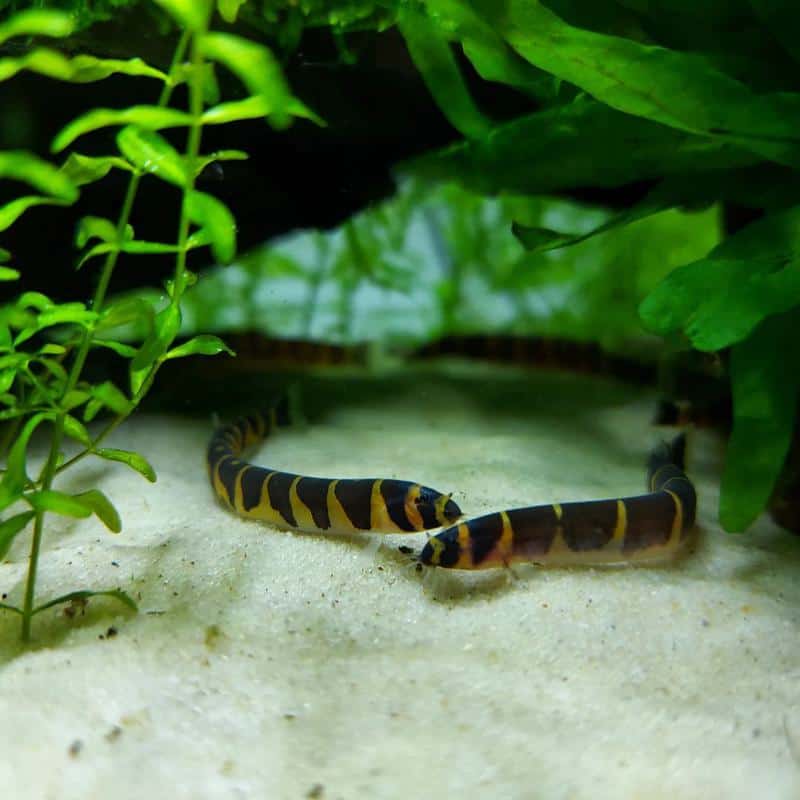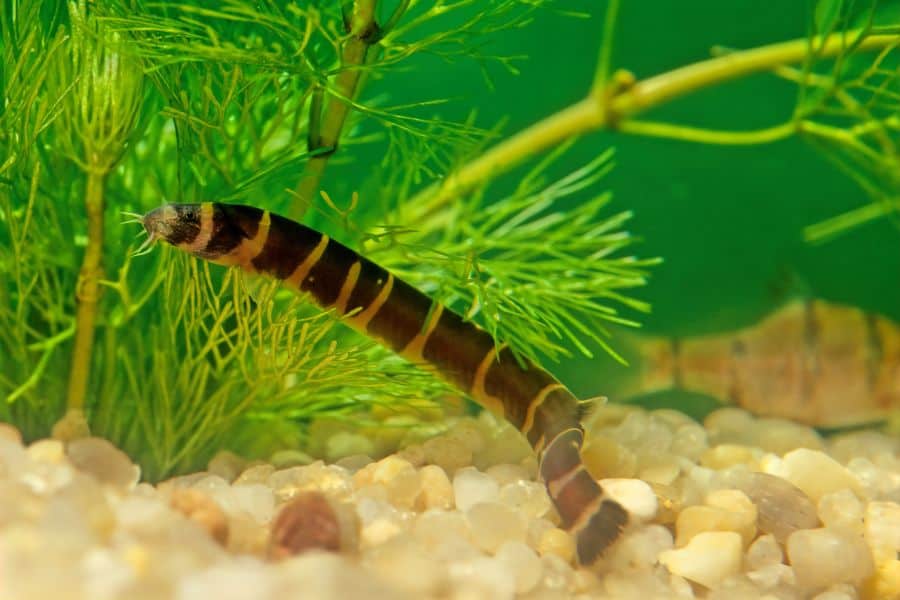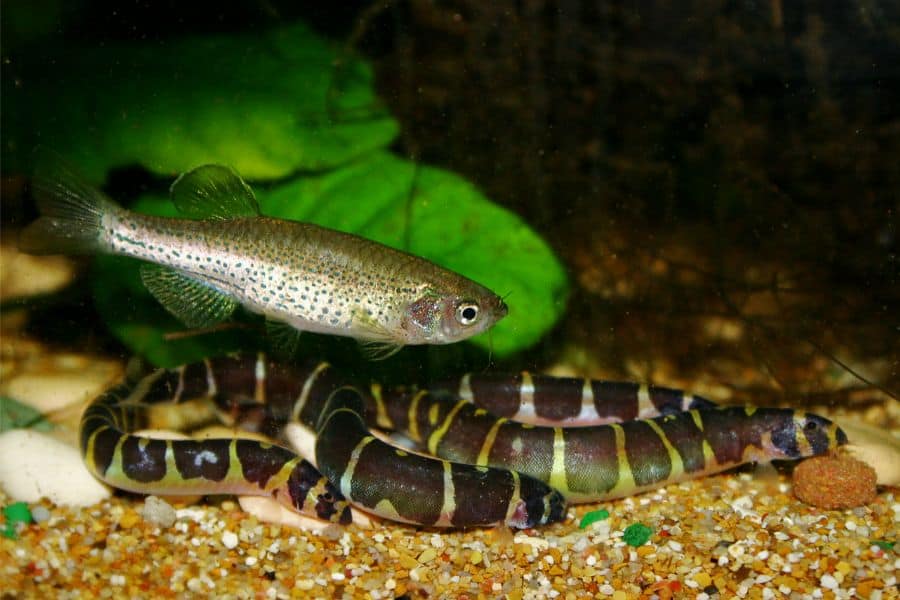Kuhli loaches are attractive, readily available, cool to watch, easy to care for, beginner friendly, and extremely hardy. What else can you ask for?
If you are afraid of snakes or wriggly-like creatures, then you may want to reconsider getting kuhli loaches. However, if that is a non-issue, then you won’t go wrong with these loaches.
They are popular among beginners and experts alike and will be a good addition to any tank since they are small, peaceful, and can get along with many tank mates.
For less than $30, you can have an energetic school of kuhli loaches that will decorate your tank and bring life to it.
Read on to dive into a complete care guide of this loach family species. Get to know the kuhli loach’s origin, natural habitat, behavior,
Kuhli Loach Species Overview
| Names | Kuhli loach
Popularly known as eel loach. Coolie loach, leopard loach, eel loach |
| Scientific Name | Pangio kuhli |
| Origins and Reginal Distribution | Originated from islands in Indonesia, Java, and Sumatra, and other parts of Southeast Asia, including Malaysia, Thailand, and Borneo. |
| Tank Size | 25 gallons minimum for a community (less than 10 tank mates) |
| Water Hardness Conditions | 2- 5 dkH |
| Ideal Tank Mates | Less aggressive, equal-sized fish. |
| Average Size | 3-4 inches, up to 5 inches in the wild |
| Colors | The most common is a light tan base with 10 – 15 dark brown stripes |
| Average Lifespan | Can live up to 10 years in an aquarium |
| Lighting Conditions | Medium to lower light levels |
| Diet | Omnivorous |
| Optimal pH levels | 6 – 7 |
| Optimal Temperature | 75 – 85 degrees Fahrenheit |
Commonly known as the eel or kuhli loach, the Pangio kuhli is a species that originates from slow-moving waters in Southeast Asian systems, including rivers, streams, and flooded forests. They are prone to seeking shelter in submerged vegetation and leaf litter.
Shallow, slow-moving streams stained with tannins and lots of aquatic plants make them a hard species to breed in captivity. This is why most kuhli loaches in stores come from the wild; they are wild-caught instead of being bred in the tanks.
Kuhli Loach Lifespan
Because of their hardy nature, they are among the few loaches with a long lifespan. A typical kuhli loach can live up to 10 years in an ideal environment.
Appearance
Regardless of the different types of kuhli loaches that exist, they all have the same average lifespan, average size, behaviors, habitat, and environmental constraints.
Size
The average kuhli loach size is about 3 to 4 inches. Some wild caught ones may be longer (up to 5 inches), but this is rare.
Due to their small size, they have a lower bioload, making them easy fish to care for and, thus, a good choice for beginners.
What Do Kuhli Loaches Look Like?
The fish’s coloration is a wide band pattern made of a light tan base color populated with 10 – 15 dark brown stripes. The coloration is similar to that of a tiger.
This is the most common color; some call it the true kuhli loach, but there are other types, all distinguished by their coloration.
Popular types of kuhli loach include:
- Black kuhli loach (Pangio oblonga) – This is the most popular variant, and it features a darker coloration. It can either be completely dark brown or completely black, with no other colors and no bands.
- Silver kuhli loach/Silver eel loach (Pangio anguillaris) – From Borneo featuring a reflective and shimmering skin with a plain silver color.
- Neon kuhli loach (Pangio doriae) – The body has a lighter pink-orange tint that is lighter than the silver color on the silver kuhli.
- Albino kuhli loach – Another color variation as a result of captive breeding. It features a pale and cream-colored body.
Like other many other loaches, the kuhli loaches also have barbells around their mouths, about four pairs. These barbells are essential in helping the fish detect food in any body of water. They are compensation for the low visibility in waters where the fish originated from that makes their eyes less dependable.
Speaking of eyes, they have small black eyes covered in transparent skin. Note that they can see using their eyes, but the barbells are their primary tool for navigating, detecting food, and sensing danger.
Kuhli Loach Behavior
Kuhli loaches are peaceful fish that do not show aggression. They are shy and spend most of their time hiding in caves, rocks, décor, and murky substrates. If you choose only to keep one in your tank, then there is a good chance you will never see the fish out in the open.
However, in a school of about 6 – 10, the kuhli loaches are among the most playful and amusing bunch you will ever see. They spend a lot of time zooming around and noodling during the day and night when they are comfortable in a large group. Very cute and entertaining.
You will see them more often if you have a planted tank with caves, wood, rocks, décor, and plenty of hiding spots. They will also hang out on branches and leaves, especially when you have native items like water wisteria.
If you sprinkled floating foods on the tank’s surface, the loaches might swim up in a very cool stance to eat them. Seeing their elongated bodies wiggle around with their mouths vertically feeding on the food is a beautiful sight.
Kuhlis are nocturnal, meaning they are more active at night. This affects their swimming and feeding habits since you may have to feed them on a different schedule than other tank mates.
Kuhli Loach Care Guide
Tank Size & Environment
The minimum tank size for keeping kuhli loaches is 15 gallons. However, if you plan on keeping a group of 6 or more together, the minimum tank size is 25 gallons. This is enough space for them to move around freely, interact with each other, and play around comfortably.
Due to their small size, you should protect the loaches from tiny spaces they may try to squeeze through. This means covering powerhead intakes and filters. A lid on the tank will also protect them from accidentally darting out of the aquarium.
They get injured easily on rocky or sharp substrates, making sandy substrate ideal. The sandy substrate (or an inequivalent smooth substrate) also provides the perfect medium for them to dig around for food.
Driftwood, Java, fern, Anubis, and dried Indian Almond leaves placed at the bottom of the aquarium will go a long way in simulating their natural habitat, which is filled with leaf litter and murky vegetation.
The more hiding spots you have, the more out and about they will be. They feel safer in such environments and are likelier to come out and play with others. Also, to encourage playfulness and socializing, ensure you place them in a group of more than five kuhli loaches.
Kuhli Loach Tank Mates
If you are wondering how many kuhli loaches should be kept together, then you should know that the minimum number is five. Six up to ten is preferable so long as the tank is large enough.
Please ensure that you do not include aggressive or bigger tank mates like cichlids and large barbs or catfish.
Some of the best tank mates for the Kuhli loaches include:
- Other kuhli loaches
- Tetras
- Betta fish
- Gouramis
- Livebearers
- Rasboras
- Corydoras
- Clown plecos
- Peacock gudgeon
- Danios
- Otocinclus catfish
Water Conditions
Kuhli loaches are hardy and can withstand a wide range of water parameters.
For example, their natural habitat pH level is between 6 – 7. However, the fish can survive in a tank of pH 7.5 – 8.5. Acidic waters on the lower side are recommended, but you won’t have to worry too much if you exceed them a little.
They can also survive in high-temperature environments, and colder weather slightly below 75 degrees Fahrenheit is also survivable.
One thing to be careful with is the water’s hardness. Kuhli loaches should be kept in softer waters, not exceeding 5 dkH. And like other aquatic animals, you should ensure you keep the water conditions stable so as not to shock the fish with big or sudden changes.
It is also recommended to only perform regular smaller water changes (10% on a bi-weekly basis), nothing too aggressive.
The ideal water parameters are as follows:
- Water Temperature: 75 – 85 degrees Fahrenheit
- pH level: 6 – 7
- Water hardness: 2 – 5 dkh
Kuhli Loach Diet
Kuhli loaches are omnivores which makes their diet more versatile and readily available. You won’t have any problems finding the perfect food for them since they are not picky about their favorite foods.
The main thing to remember is that you need to have small sinking foods. Kuhli loaches are bottom-dwelling fish that spend most of their feeding time scavenging for food at the bottom. They sometimes dart to the surface to eat floating foods, but most of their time is spent at the bottom.
Small-sized sinking foods ensure they get their meals easily, avoiding straining them or stressing them into competition with others.
Remember to add food to the tank once you switch off the lights at night. Kuhli loaches are more active at night and must be fed during slumber hours.
Feed them on several occasions throughout the day. The best way to measure how much you can feed them is to see how fast they finish the food you throw in in a few minutes. If there are leftovers, then they are full; otherwise, keep feeding them.
Some of the best foods for kuhli loaches include:
- Frozen bloodworms
- Frozen krill
- Water fleas
- Brine shrimp
- Tupifex
- Earthworms
- Freeze-dried foods.
- Standard catfish pellets, flakes, and other frozen foods
- Vegetables like peas, spinach, cucumber, broccoli, lettuce, and zucchini
- Fry foods
- Aquarium coughs
- Fluval bug bites
- Repashy gel foods
- Mosquito larvae
- Daphnia
Side note, do kuhli loaches eat snails? Or any other small aquatic life for that matter?
According to reports and observations, kuhli loaches are not known for eating snails or shrimps. This is contrary to what we normally see with other species in the loach family.
However, it is crucial to remember that even though kuhli loaches are peaceful omnivores, they are still opportunistic scavengers capable of eating anything small enough to fit into their mouths.
This opportunistic behavior makes kuhli loach among the hardiest small fish. They can live off microorganisms and plant matter for a long time.
Add this to their ability to withstand wide ranges of water conditions, and you have strong, hardy fish that live up to 10 years.
Breeding

Breeding kuhli loaches in captivity is still a mystery. Only a few unplanned breeding have been reported, and it is usually in aquariums with lots of planted vegetation and zero-predatory fishes.
Majority of kuhli fish in stores are straight from their wild native regions. In fact, Thai fisheries are among the biggest suppliers of these loaches since they breed them in captivity in their native regions.
Experts have yet to crack the code on triggering spawning in regular aquariums. It is hard and requires a particular set of conditions that must be met precisely.
With that said, there are a few steps you can take to get closer to breeding these fish:
Step 1: Identify the Right Time
Healthy females will occasionally fill with kuhli loach eggs, and this will be clear when you notice their bellies become plumper and fatter/more pronounced –the stomachs typically turn into a light greenish color.
This difference between females and males is only visible during the breeding period. Otherwise, the two genders look extremely identical throughout their lives.
Step 2: Separate the Breeding Fish Into a Different Tank
Kuhli loaches are communal breeders, so you won’t have to pair them up to breed. All you need is to gather a large group of pregnant females and fertilizing males and place them in a separate tank.
A group of males will gather around the female that is ready to lay her eggs so that they can fertilize them. The bigger the two groups, the better. A ratio of 2 males to 1 female is great.
The separate tank should be set up to simulate the wild native environment where the fish freely breed. Otherwise, it might not work. A good place to start is to include tropical blackwater bogs, a thick mass of java moss, marches, and lots of hiding spots.
You will need a bigger tank for breeding, about 100 gallons minimum for a large group of loaches. Proceed to ensure the environment, temperature, pH, and diet are as close to that of the wild natural habitat as possible. The closer the simulation, the more likely they are to breed.
The best parameters to breed include the following:
- Temperature: above 82 degrees Fahrenheit
- Diet: Frozen foods, love fish, bloodworms, fry brine shrimp, tubifex,
- Water pH levels: Above 6.5
Step 3: Breeding Starts & Eggs Hatch
The female will then lay the eggs in the ideal environment once it chooses a mate. The two will then spawn typically at night since they prefer low lighting, which will be done on the tank’s surface amidst floating vegetation.
Put floating plants like water lettuce at the surface where the green kuhli loach eggs will get laid.
So, will kuhli loaches eat fish eggs? The answer is yes. You must remove the fish from the tank at this point since the loaches tend to eat their eggs. You can place the eggs in a different fry-rearing tank.
It will take up to 2 days before the eggs hatch, and you should feed the young juvenile fish live foods (infusoria is a good choice) once they hatch.
Kuhli Loach Price
Due to their availability and popularity, the Kuhli loaches are affordable and highly cheap in many local shops and online markets.
You can expect to pay about $3.00 per fish for this species.
Also Read: Dojo Loach
Conclusion
Kuhli loaches are perfect for small planted tanks with less than 25 gallons of water. They are energetic and playful in groups, making them ideal for those looking for an entertaining group of fish.
Their small sizes make them easy to take care of and give you the space to add more when you upgrade your setup. If you are unsure about kuhli loaches, their attractive tiger-like bands may just be what entices you.


